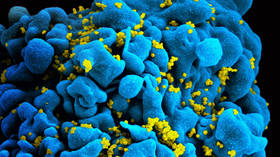HIV can be fooled into an ambush by killer cells – study

Researchers have refined a ‘kick and kill’ approach targeting dormant HIV particles by tricking them out of infected cells into the open to be attacked by the body’s natural killer cells, offering hope for a potential cure.
The study, whose findings were published in the Nature Communications journal, involved lab tests on 10 HIV-infected mice. A team of scientists from UCLA reported that the AIDS-causing virus was completely eliminated in some 40% of cases.
The new research was the continuation of an approach devised in 2017
that saw the team administer a synthetic agent called SUW133 to activate dormant HIV in infected mice. The chemical compound, developed at Stanford University, tricks the viral cells into revealing themselves.
After that study saw some 25% of the HIV-infected cells die within 24 hours, the scientists sought to improve efficiency this time around by injecting healthy natural killer cells into the mice. The combined approach worked better than using either the agent or the killer cells by themselves.
“These findings show proof-of-concept for a therapeutic strategy to potentially eliminate HIV from the body, a task that had been nearly insurmountable for many years,” Jocelyn Kim, the study’s lead author, said, adding that they open a “new paradigm for a possible HIV cure in the future.”
The team’s goal is now to eliminate 100% of HIV from the infected mice subjects.
Kim said that the research will then move toward “preclinical studies in non-human primates” with the “ultimate goal” of human testing.
If it proves safe and effective in human trials, the approach could remove the need for people with HIV to depend on lifelong courses of anti-retroviral (ARV) medications. Those drugs do not kill the virus, but work to inhibit it at stages in its ‘life cycle’ – for instance, after it infiltrates a host cell or when it begins to replicate itself.
Although ARVs suppress the virus to nearly undetectable levels, it lies dormant in the body’s CD4+ T cells, which are usually part of a healthy immune system response. Then, when the ARV treatment is stopped, the HIV escapes and continues to spread.
According to UN estimates, some 38 million people worldwide currently live with HIV.













